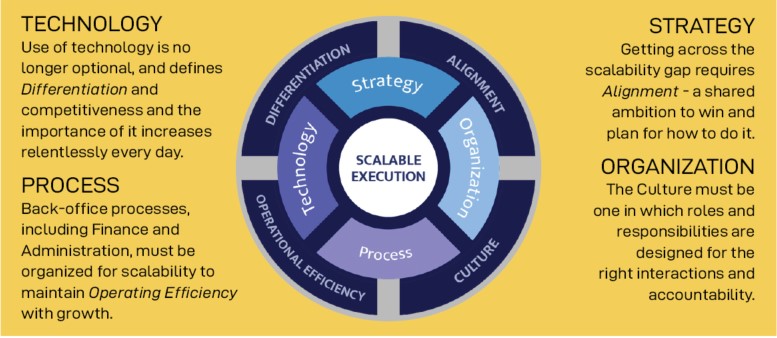In Order to Grow, You Have to Bridge the Gap
To scale up successfully, leadership needs to adopt certain principles
"If a company has figured out how to deliver value to the market and is good at selling that value, it’s going to grow,” says Kendall Hoyd, president of the Sharpen Group, a consulting firm specializing in companies with $5M to over $4B in revenue. “But all growing businesses eventually reach a size where successful growth will require more management, guidance, and alignment than the owner can provide personally.”
Bridging the Scalability Gap
Presenter:
Kendall Hoyd, The Sharpen Group
Moderator:
Jeff Taake, Mead Lumber
How far can your company grow before scalability becomes an issue? According to Kendall, it depends, but based on more than a dozen successful companies he’s worked within and helped grow, he estimates that it’s approximately 100 employees. “I have found that’s about the maximum number of rear ends one person can kick in a day,” jokes Kendall.
When he walks into a company, Kendall says he starts by poking around the accounts payable department. “They interact with every part in the company, as well as with all your suppliers,” Kendall explains. “If there isn’t good enough cohesion to get all the bills paid efficiently, it’s going to drag down the business because the rework affects everyone.” Worse, it is a symptom of lack of effective process and alignment throughout the organization.
When leading a growing component manufacturer (CM) operation, Kendall says its easy to overestimate alignment within the company, and to assume everyone within the organization has the same priorities. “I found that as you grow, you have to change how you communicate,” explains Kendall. “You have to reduce the number of things you say and say a few key things much more often.
A leader should be reiterating key concepts so often that, as Kendall humorously suggests, employees should be mocking the leader. “If they can mock you for it, they’ve internalized the concept,” says Kendall. “If they’ve internalized it, there isn’t any confusion over what your priorities are.”
Each key concept should be “repeatable and scalable,” so that when someone is introduced to it, he or she can easily understand it and act upon it. “As a leader of a growing organization you have to be able to streamline your communication to values and priorities,” Kendall adds. “Then trust your management team to translate them into the work that needs to get done.”
A written strategic plan is a powerful translation tool. As Kendall explains, “You cannot scale if your management doesn’t go on record as to what they believe and want to do.” Without it, it’s very easy for the “truth” everyone is operating under to change without leadership knowing. Creating a strategic plan requires the organization to match words and tasks to the values and priorities leadership has repeatedly articulated. “It is a very effective way to determine an organization’s level of alignment,” he says.
Kendall explains a strategic plan is the key element of strategy, one of four foundational elements that combine to enable a business to grow successfully. “If implemented well, these four elements can enable as much growth as the company’s sales team can generate,” he says. Illustration 1 shows the other three elements are organization, process, and technology.

Organization is about institutionalizing your company’s desired culture. “To grow, a business has to organize and delegate its responsibilities in a way that keeps the leaders and their teams focused on the customers,” Kendall points out. “It also keeps people connected to their work and what makes it rewarding, while also ensuring accountability and clear division of responsibility.”
Perhaps the most important element of successful rapid growth is an organization’s ability to transition to one that is focused on process. “Many businesses get stuck at the size of the number of highly talented people they can find for certain roles,” Kendall explains. “Businesses at the next level of scale and value find a way to get leverage out of processes that get the same or better results from people that are not as uniquely talented.”
Kendall suggests dependence on “heroism,” is likely an issue of process. “If your culture celebrates those who repeatedly go to great lengths to get the job done or make the customer happy, that isn’t scalable,” warns Kendall. “A pattern of repeated heroism is actually a symptom of the mentality that there’s no time to do things right the first time.”
In today’s business environment, if technology and strategy are not intertwined and inseparable, growth will be difficult. “Simply put, if you aren’t thinking about what your business should be able to do for its customers and how technology can enable great leaps in productivity and value creation, you are going to get left behind by people who are,” Kendall says.
The idea is that these four elements work together to create a working environment and value proposition that actively drive growth. “Done well, your organization will have the alignment, culture, and operational efficiency needed to scale to whatever size the market will support,” says Kendall. “Beyond a clear value proposition, the company will also clearly differentiate itself from its competitors by being faster and more focused.”
